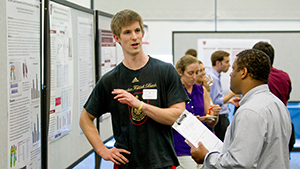May 5, 2014 - By Tracie White

Yannick Goeb discusses his poster with judge Jonathan Perez, the director of MD admissions at Stanford, at the Medical Student Research Symposium on May 1. Credit: Norbert von der Groeben
The research interests of Stanford medical students stretch far and wide, from determining how vaccination against the rotavirus works, to uncovering shocking homicide statistics for recently released juvenile offenders, to exploring the outcomes of male-to-female gender reassignment surgery.
"It's been an amazing learning experience," said Grace Laidlaw, one of 36 medical students who presented posters about their research May 1 at the 31st annual Stanford Medical Student Research Symposium. "I've learned so much, especially in the fields of virology and immunology."
Like many of the students participating in the symposium at the Li Ka Shing Center for Learning and Knowledge, Laidlaw chose a field of research that she has considered pursuing after graduation.
While completing her second year of medical school, Laidlaw, 25, has spent what spare time she has researching the mechanisms of how the rotavirus vaccine works. Her mentor for the project, Harry Greenberg, MD, senior associate dean for research and professor of medicine and of microbiology and immunology, is a rotavirus and vaccine expert. Rotavirus is a common cause of severe diarrhea in children.
"We're researching how the rotavirus interacts with everything in a cell," Laidlaw said. "We hope the research could help make a better vaccine. Maybe it could help lead to an oral vaccine rather than an injection."
The students squeeze in their research, focusing on contemporary health issues, in between schoolwork and clinical care education, over summers, during Christmas breaks.
Lars Osterberg, MD, clinical associate professor of medicine, was on hand to help judge the quality of the research and poster presentations. Ten projects were named winners, and the student investigators awarded $200. He applauded the students' ability to conduct research while completing medical school.
"It's probably why most medical students at Stanford take five years instead of four to graduate, but I think it's worth it," he said. "Whether they become research physicians or just physicians who read research papers critically, it makes them better doctors."
In an effort to explore his interest in pediatrics, Gregory Gaskin, another second-year medical student, has been working with Arash Anoshiravani, MD, clinical assistant professor of pediatrics, in Santa Clara County juvenile detention facilities. His poster presentation was titled "Mortality among former juvenile offenders in California."
By examining two large state databases on released juvenile offenders, he found that 62 percent of juveniles released from detention centers were victims of homicide.
"Unfortunately, I wasn't surprised by these results," Gaskin said. "This is a population that is easily ignored." He said the work helped to further his interest in a career in pediatric medicine.
Winners of 31st annual Medical Student Research Symposium poster presentations
- Even Chen, "Targeting kit in colon cancer." Mentor: Michael Clarke, MD, professor of oncology.
- Gregory Gaskin, "Mortality among former juvenile offenders in California." Mentor: Arash Anoshiravani, MD, clinical assistant professor of pediatrics.
- Tessa Johung, "Optogenetic techniques to demonstrate neuron activity-dependent proliferation of pediatric glioma cells in vivo." Mentor: Michelle Monje, MD, PhD, assistant professor of neurology.
- Vivian Lei, "Creating a pilot transition-to-internship curriculum for graduating Stanford medical students." Mentor: Clarence Braddock, MD, former associate dean for undergraduate and graduate medical education.
- Shane Morrison, "Long-term outcomes of rectosigmoid neocolporraphy in male-to-female gender reassignment surgery." Mentor: Thomas Satterwhite, MD, plastic surgery resident.
- Noelle Pineda, "Exploring the health and social needs of at-risk transition age youth in San Jose, California." Mentor: Lisa Chamberlain, MD, assistant professor of pediatrics.
- Tania Rezai, "Integrative medicine and the underserved: What are the barriers?" Mentor: Tracy Rydel, MD, clinical assistant professor of medicine.
- Ulysses Rosas, "Does a dietician improve bariatric surgery outcomes?" Mentor: John Morton, MD, associate professor of surgery.
- Aatman Shah, "Optogenetic stimulation of the cerebellar dentate nucleus as a novel therapeutic technique to promote neuronal activity, plasticity, and functional recovery after stroke." Mentor: Gary Steinberg, MD, PhD, professor of neurosurgery.
- Graham Walmsley, "Identification and targeted inhibition of a fibroblast lineage responsible for scarring and cancer stroma." Mentor: Michael Longaker, MD, professor of surgery.
About Stanford Medicine
Stanford Medicine is an integrated academic health system comprising the Stanford School of Medicine and adult and pediatric health care delivery systems. Together, they harness the full potential of biomedicine through collaborative research, education and clinical care for patients. For more information, please visit med.stanford.edu.